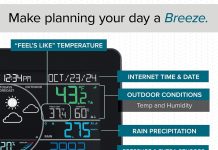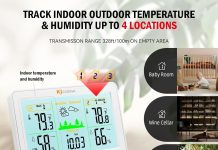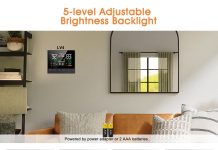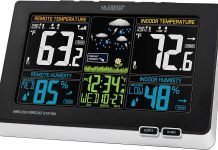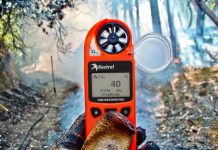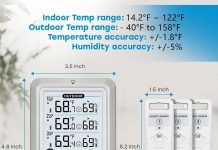Curious about the different accessories you can add to your home weather station? Look no further! In this article, we explore the wide range of accessories that can enhance your weather station experience. From rain gauges to wind sensors, these add-ons provide valuable data and allow you to track and analyze weather conditions with precision. So, whether you’re a weather enthusiast or simply want to stay informed, read on to discover the exciting world of home weather station accessories.
Review contents
Mounting Accessories
Tripods
When it comes to setting up a home weather station, having a sturdy tripod is essential. Tripods provide a stable base for mounting the weather station and help ensure accurate readings. They come in various heights and materials, allowing you to choose the one that suits your needs best. Whether you plan to set up your weather station in your backyard or on your rooftop, a tripod will provide the necessary stability for reliable weather data.
Poles
If you need to elevate your weather station for better visibility or to avoid obstacles that could affect its readings, poles can be a great solution. Poles come in different lengths and materials, allowing you to customize the height and durability according to your specific requirements. Whether you want to place your weather station above plants and trees or if you need to clear any obstructions such as buildings, poles provide flexibility in positioning your sensors.
Wall Mounts
For those who prefer to mount their weather stations on a wall, wall mounts offer a convenient option. Wall mounts are ideal for homeowners who may not have ample ground space or who want to place their weather station closer to their home. These mounts are designed to securely hold the weather station in place, ensuring accurate and reliable data collection even when space is limited. Wall mounts are available in different designs and materials to cater to various weather stations.
Sensors and Instruments
Additional Temperature Sensors
While most weather stations come with a built-in temperature sensor, some enthusiasts may require additional temperature sensors to monitor temperature variations in different locations. These sensors can be placed indoors and outdoors to measure ambient and external temperatures simultaneously. By having more temperature sensors, you can gain a more comprehensive understanding of how temperature fluctuates throughout your property or neighborhood.
Humidity Sensors
Humidity plays a significant role in weather conditions and can greatly impact our comfort levels. Humidity sensors are essential accessories that monitor and measure the moisture content in the air. With a humidity sensor, you can accurately track the humidity levels both indoors and outdoors, providing valuable insights into the overall comfort of your environment. By analyzing the humidity data, you can make informed decisions about ventilation and manage conditions that might contribute to mold or mildew growth.
Wind Speed and Direction Sensors
Wind speed and direction sensors are crucial for accurate weather forecasting and understanding local weather patterns. These sensors measure the speed and direction of the wind, providing real-time data on wind conditions. By integrating these sensors into your weather station, you can track how wind speed and directions change over time. This information is invaluable for activities such as gardening, outdoor events, or even identifying potential wind-related hazards.
Rain Gauges
If you’re interested in tracking precipitation, a rain gauge is an essential accessory for your weather station. Rain gauges provide accurate measurements of rainfall, allowing you to monitor precipitation levels in your area. Knowing how much rain has fallen can help you manage your garden, plan outdoor activities, and even prepare for potential flooding or erosion. Rain gauges come in different designs, including manual and automatic options, to suit your preferences and needs.
Barometric Pressure Sensors
Barometric pressure sensors, also known as atmospheric pressure sensors, measure the pressure exerted by the atmosphere. Changes in barometric pressure can indicate imminent weather changes, such as approaching storms or clear skies. By including a barometric pressure sensor in your weather station, you can keep track of atmospheric pressure variations and make more accurate weather predictions. Understanding barometric pressure trends can also be beneficial for individuals with certain health conditions, as they may experience symptoms related to changes in pressure.
UV Index Sensors
UV index sensors are designed to measure the intensity of ultraviolet (UV) radiation from the sun. Monitoring UV levels is crucial for protecting yourself from harmful sun exposure and preventing conditions such as sunburn and skin cancer. With a UV index sensor integrated into your weather station, you can easily access real-time data on UV index levels. This information can help you make informed decisions about sun protection and outdoor activities. UV index sensors are particularly useful for individuals who spend a lot of time outdoors, such as gardeners or athletes.
Data Loggers and Recorders
Indoor Data Loggers
Indoor data loggers allow you to collect and store weather data from sensors placed indoors. These loggers capture information such as temperature, humidity, and atmospheric pressure, allowing you to monitor indoor conditions over time. With indoor data loggers, you can analyze trends, identify patterns, and make informed decisions about ventilation, heating, or cooling in your home. Some indoor data loggers also provide the functionality to connect to your computer or mobile device for easy access to data and analysis.
Outdoor Data Loggers
If you want to monitor weather conditions specifically outdoors, outdoor data loggers are the perfect accessory for your weather station. These loggers enable you to capture and record data from sensors placed in your garden, backyard, or any outdoor location. By using an outdoor data logger, you can track temperature variations, humidity levels, wind speed and direction, and other weather parameters specific to your outdoor environment. Outdoor data loggers provide a comprehensive view of weather conditions at your location, helping you make informed decisions about outdoor activities or gardening.
WiFi Data Loggers
With the rise of smart homes and connected devices, WiFi data loggers have become increasingly popular for home weather stations. These loggers allow you to connect your weather station to your home’s WiFi network, enabling real-time data transmission and remote access. WiFi data loggers provide the convenience of accessing weather data from anywhere using your computer or mobile device. Whether you’re at work, traveling, or simply indoors, you can stay informed about weather conditions at your home with just a few taps or clicks.
SD Card Recorders
SD card recorders offer an alternative method of data logging and storage for weather stations. These recorders utilize SD memory cards to capture and store weather data directly from the sensors. SD card recorders eliminate the need for a constant internet connection or computer connection, making them a reliable and independent option for data collection. By regularly transferring the SD card to your computer, you can analyze and visualize the collected data at your convenience.
Display Units and Monitors
Desktop Display Units
Desktop display units provide a convenient way to view real-time weather data directly on your desk or countertop. These compact units integrate with your weather station to display information such as temperature, humidity, wind speed, rainfall, and more. Desktop display units often feature easy-to-read screens, customizable settings, and user-friendly interfaces. They provide a quick snapshot of the current weather conditions in your area without the need to access a computer or smartphone.
Wireless Display Monitors
Wireless display monitors offer a flexible solution for viewing weather data from a distance. These monitors receive data wirelessly from your weather station, allowing you to place them in any room of your home or office. Wireless display monitors provide real-time updates on temperature, humidity, wind speed, and other weather parameters. With their clear and easy-to-read displays, you can quickly assess the weather conditions without physically accessing your weather station or relying on a computer or mobile device.
Smartphone Apps
In today’s digital age, smartphones have become an integral part of our daily lives. With dedicated weather apps, you can transform your smartphone into a portable weather station. These apps receive data from your weather station and provide real-time updates on weather conditions. With the convenience of smartphone apps, you can carry the power of weather monitoring in your pocket wherever you go. Smartphone apps often offer additional features such as weather alerts, historical data analysis, and customizable settings.
Weather Camera
A weather camera is a fantastic accessory for capturing visuals of your local weather conditions. These specialized cameras are designed to withstand various weather elements and provide live video or snapshots of the sky, clouds, or specific weather events. Weather cameras add an extra dimension to your weather station setup, allowing you to visually observe weather patterns and changes. Whether you’re a weather enthusiast, a photographer, or simply want to share your local weather with others, a weather camera is a valuable addition to your home weather station.
Lightning Detection Systems
Lightning Detectors
Lightning detectors are essential for anyone who wants to monitor and detect lightning activity in their area. These detectors use advanced technology to detect the electromagnetic signals produced by lightning strikes. By integrating a lightning detector into your weather station, you can receive real-time alerts and warnings when lightning occurs nearby. This knowledge helps you take necessary precautions and ensure the safety of yourself, your family, and your property.
Lightning Alert Systems
Lightning alert systems provide an additional layer of protection by notifying you about nearby lightning in real-time. These systems often include audible alarms, visual indicators, and remote notifications to ensure you are aware of potential lightning threats. Lightning alert systems can be integrated with your weather station, allowing them to monitor lightning activity and react accordingly. With a lightning alert system in place, you can take proactive measures to stay safe during inclement weather.
Solar Power Accessories
Solar Panels
Solar panels are a sustainable and environmentally-friendly option for powering your weather station. By harnessing the power of the sun, solar panels can provide a continuous and reliable source of energy, eliminating the need for batteries or a constant connection to the electrical grid. Solar panels can be installed near your weather station to charge batteries or power your sensors directly. With solar panels, you can reduce your carbon footprint while ensuring uninterrupted operation of your weather station.
Solar Power Banks
Solar power banks offer a portable and convenient way to charge or power your weather station when sunlight is not readily available. These power banks equipped with solar panels allow you to store solar energy and use it when needed. Whether you’re on a camping trip, an outdoor expedition, or simply in an area with limited access to electricity, solar power banks ensure that your weather station remains functional. With their compact and lightweight designs, solar power banks are perfect for on-the-go weather monitoring.
Antenna and Signal Boosters
For individuals with weather stations located in areas with weak or unreliable signal reception, antenna and signal boosters are crucial accessories. These devices amplify and enhance the reception strength of signals between your weather station and the sensors. Antenna and signal boosters ensure a stable and consistent connection, resulting in accurate and uninterrupted transmission of weather data. Whether your weather station is situated in a rural area or a location with obstacles, antenna and signal boosters provide a reliable solution for maintaining connectivity.
Weather Station Software
PC Software
PC software offers an extensive range of features and advanced capabilities for weather station enthusiasts. These software applications allow you to connect your weather station to your computer and access detailed data analysis, visualization, and historical reports. With PC software, you can dive deep into your weather data, create custom graphs, compare trends, and even share your findings with the weather community. PC software is ideal for those who want comprehensive weather monitoring tools and require in-depth data analysis.
Mobile Apps
Mobile apps provide the flexibility of accessing and monitoring your weather station from your smartphone or tablet. These apps offer a user-friendly interface with essential weather information such as temperature, humidity, wind speed, and more. Mobile apps often include additional features like weather alerts, hourly forecasts, and historical data summaries. With mobile apps, you can conveniently stay updated on the weather conditions while on the go. Whether you’re planning outdoor activities or need to make a quick weather-related decision, mobile apps have got you covered.
Conclusion
Home weather stations offer a wealth of information about local weather conditions and provide valuable insights for various purposes. With the wide range of accessories available, you can enhance the functionality and versatility of your weather station. From mounting accessories to data loggers, display units, lightning detection systems, solar power accessories, antenna boosters, and software options, there are endless possibilities to customize and optimize your weather station setup. Whether you’re an avid weather enthusiast, a gardener, or someone who simply enjoys staying informed about weather conditions, investing in these accessories will take your weather monitoring experience to the next level. So, go ahead and choose the accessories that best suit your needs and embark on a journey of exploring the exciting world of weather observation!


